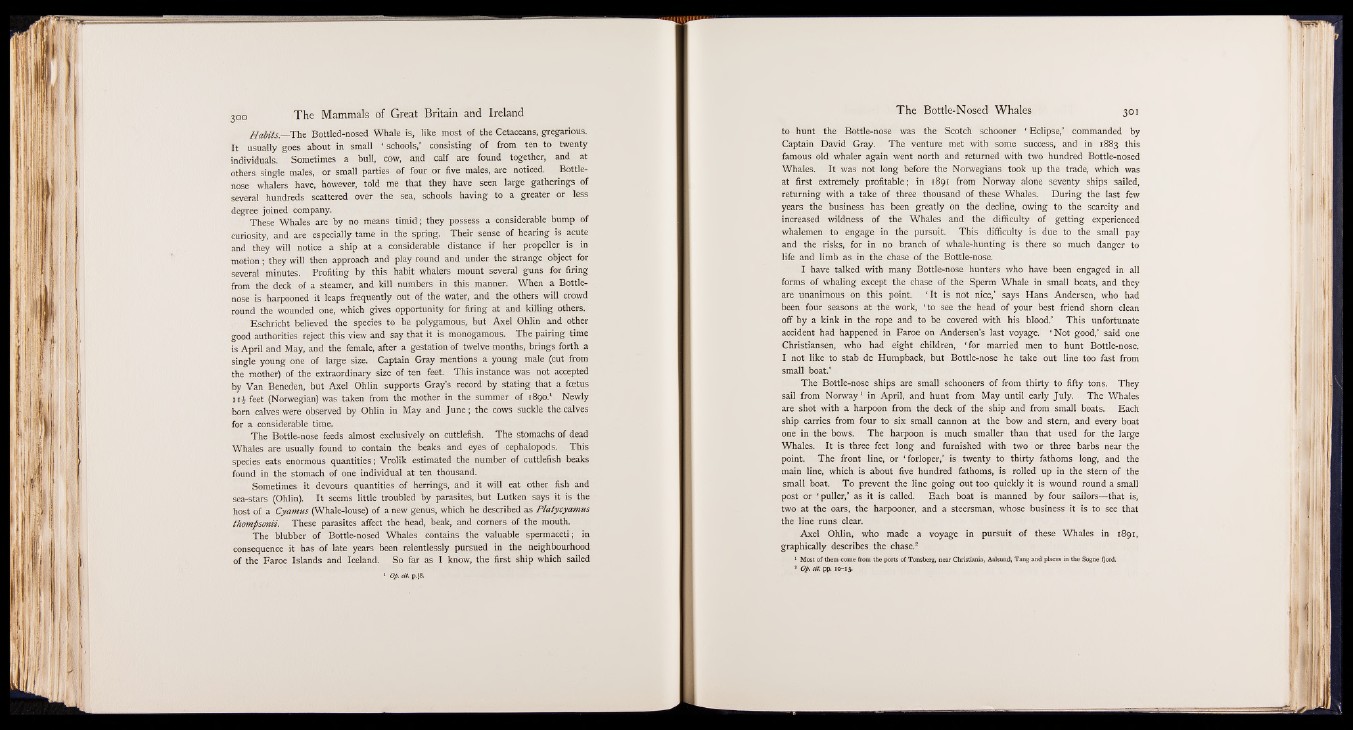
Habits.— The Bottled-nosed Whale is, like most of the Cetaceans, gregarious.
It usually goes about in small ‘ schools,’ consisting of from ten to twenty
individuals. Sometimes a bull, cow, and calf are found together, and at
others single males, or small parties of four or five males, are noticed. Bottlenose
whalers have, however, told me that they have seen large gatherings of
several hundreds scattered over the sea, schools having to a greater or less
degree joined company.
These Whales are by no means timid; they possess a considerable bump of
curiosity, and are especially tame in the spring. Their sense of hearing is acute
and they will notice a ship at a considerable distance if her propeller is in
motion; they will then approach and play round and under the strange object for
several minutes. Profiting by this habit whalers mount several guns for firing
from the deck of a steamer, and kill numbers in this manner. When a Bottle-
nose is harpooned it leaps frequently out of the water, and the others will crowd
round the wounded one, which gives opportunity for firing at and killing others.
Eschricht believed the species to be polygamous, but Axel Ohlin and other
good authorities reject this view and say that it is monogamous. The pairing time
is April and May, and the female, after a gestation of twelve months, brings forth a
single young one of large size. Captain Gray mentions a young male (cut from
the mother) of the extraordinary size of ten feet. This instance was not accepted
by Van Beneden, but Axel Ohlin supports Gray’s record by stating that a foetus
I i i feet (Norwegian) was taken from the mother in the summer of 1890.1 Newly
born calves were observed by Ohlin in May and June; the cows suckle the calves
for a considerable time.
The Bottle-nose feeds almost exclusively on cuttlefish. The stomachs of dead
Whales are usually found to contain the beaks and eyes of cephalopods. This
species eats enormous quantities; Vrolik estimated the number of cuttlefish beaks
found in the stomach of one individual at ten thousand.
Sometimes it devours quantities of herrings, and it will eat other fish and
sea-stars (Ohlin). It seems little troubled by parasites, but Lutken says it is the
host of a Cyamus (Whale-louse) of a new genus, which he described as Platycyamus
thompsonii. These parasites affect the head, beak, and corners of the mouth.
The blubber of Bottle-nosed Whales contains the valuable spermaceti; in
consequence it has of late years been relentlessly pursued in the neighbourhood
of the Faroe Islands and Iceland. So far as I know, the first ship which sailed
to hunt the Bottle-nose was the Scotch schooner ‘ Eclipse,’ commanded by
Captain David Gray. The venture met with some success, and in 1883 this
famous old whaler again went north and returned with two hundred Bottle-nosed
Whales. It was not long before the Norwegians took up the trade, which was
at first extremely profitable; in 1891 from Norway alone seventy ships sailed,
returning with a take of three thousand of these Whales. During the last few
years the business has been greatly on the decline, owing to the scarcity and
increased wildness of the Whales and the difficulty of getting experienced
whalemen to engage in the pursuit. This difficulty is due to the small pay
and the risks, for in no branch of whale-hunting is there so much danger to
life and limb as in the chase of the Bottle-nose.
I have talked with many Bottle-nose hunters who have been engaged in all
forms of whaling except the chase of the Sperm Whale in small boats, and they
are unanimous on this point. ‘ It is not nice,’ says Hans Andersen, who had
been four seasons at the work, ‘ to see the head of your best friend shorn clean
off by a kink in the rope and to be covered with his blood.’ This unfortunate
accident had happened in Faroe on Andersen’s last voyage. ‘ Not good,’ said one
Christiansen, who had eight children, ‘ for married men to hunt Bottle-nose.
I not like to stab de Humpback, but Bottle-nose he take out line too fast from
small boat.'
The Bottle-nose ships are small schooners of from thirty to fifty tons. They
sail from Norway1 in April, and hunt from May until early July. The Whales
are shot with a harpoon from the deck of the ship and from small boats. Each
ship carries from four to six small cannon at the bow and stern, and every boat
one in the bows. The harpoon is much smaller than that used for the large
Whales. It is three feet long and furnished with two or three barbs near the
point. The front line, or ‘ forloper,’ is twenty to thirty fathoms long, and the
main line, which is about five hundred fathoms, is rolled up in the stern of the
small boat. To prevent the line going out too quickly it is wound round a small
post or ‘ puller,’ as it is called. Each boat is manned by four sailors— that is,
two at the oars, the harpooner, and a steersman, whose business it is to see that
the line runs clear.
Axel Ohlin, who made a voyage in pursuit of these Whales in 1891,
graphically describes the chase.2
1 Most of them come from the ports of Tonsberg, near Christiania, Aalsund, Tang and places in the Sogne fjord.
* Op. tit. pp. 10-13.